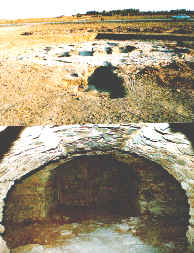|
|
Ghazali and his respected personage, his life and death in Tous, has made his devotees attempt to discover the whereabouts of his grave.
Following the suggestion of American priest, Donaldson, in 1917, many believed that "Harounieh" is Ghazali's mausoleum and tomb.
According to written testimonies, the location of Qazali's true tomb and mausoleum was outside of Tous' Wall and also because "Harounieh" architecture style belonged to 13-14th century AD, so it cannot be accepted that "Harounieh" is Ghazali's mausoleum and tomb.
With these assumptions, in 1995, in a point outside of Tous' Wall, at the distance of 100 m from the fence, known to the informed local as the tomb of Ghazali, scientific experiments resulted the discovery of architectural remains of Qazali Tomb. It was matched to the details of the eroded Ghazali Tomb, given in the book "Mihman-nameh Bukhara".
The discovered building contains two stories:
Upper floor, where all bricks have been removed and only a skeleton remained, was an octagonal area with painted walls and bricked and tiled view of the same kind, as tomb towers.
Lower floor, cross-like, four-terraced with plastered walls and an altar with green tiles erected on other sides.
On the testimony of Kufic Cornice, on the ceiling of this place, plaster-work, altar and tiles, it could be said that this place has been his mausoleum until his death; afterwards it had became his grave and a dome was constructed on the top of it, while it was still a mausoleum for the faithful and the scholar.

|
|

